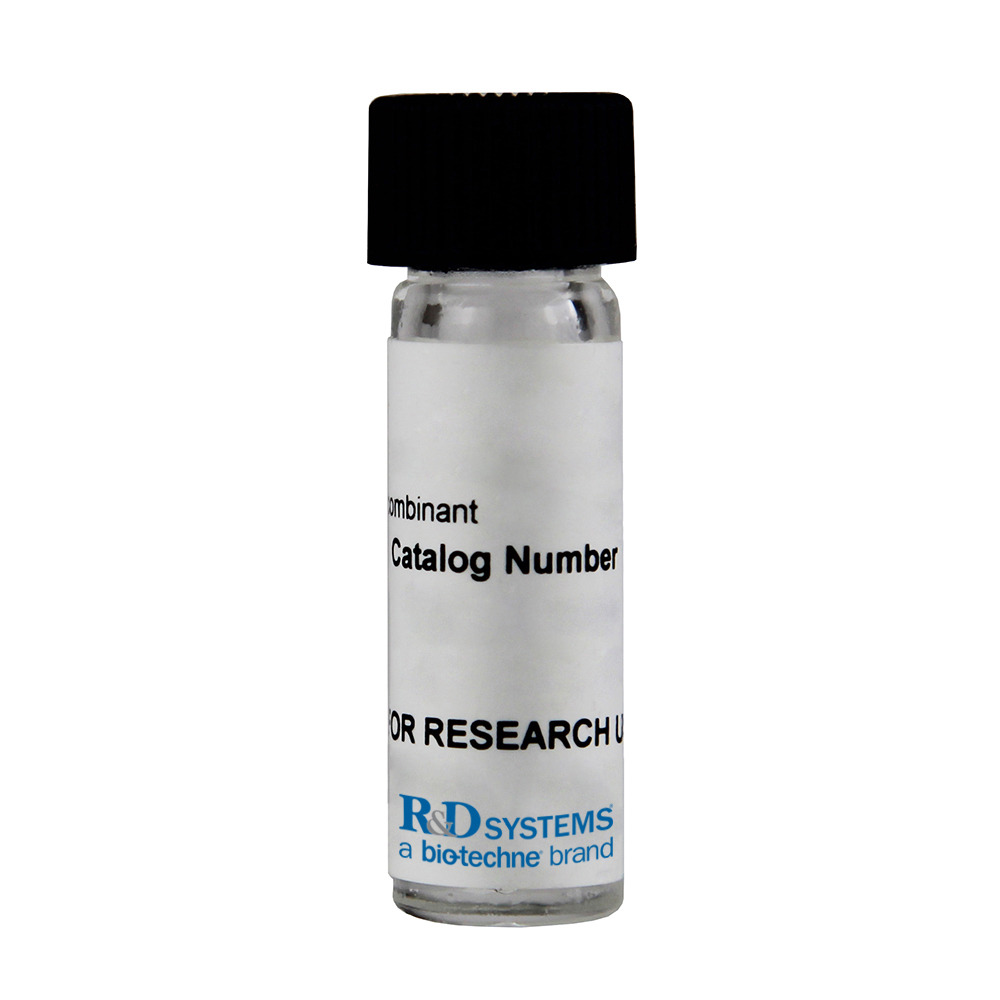 全部商品分类
全部商品分类

 下载产品说明书
下载产品说明书 下载SDS
下载SDS 用小程序,查商品更便捷
用小程序,查商品更便捷


 收藏
收藏
 对比
对比 咨询
咨询Carrier Free
CF stands for Carrier Free (CF). We typically add Bovine Serum Albumin (BSA) as a carrier protein to our recombinant proteins. Adding a carrier protein enhances protein stability, increases shelf-life, and allows the recombinant protein to be stored at a more dilute concentration. The carrier free version does not contain BSA.
In general, we advise purchasing the recombinant protein with BSA for use in cell or tissue culture, or as an ELISA standard. In contrast, the carrier free protein is recommended for applications, in which the presence of BSA could interfere.
926-AS
| Formulation | Lyophilized from a 0.2 μm filtered solution in PBS. |
| Reconstitution | Reconstitute at 200 μg/mL in PBS. |
| Shipping | The product is shipped at ambient temperature. Upon receipt, store it immediately at the temperature recommended below. |
| Stability & Storage: | Use a manual defrost freezer and avoid repeated freeze-thaw cycles.
|
Recombinant Human Angiostatin Fc Chimera Protein, CF Summary
Product Specifications
| Met-Asp | Human IgG1 (Pro100-Lys330) | IEGR | Human Angiostatin (Kringle 1-4) (Val98-Ala459) Accession # P00747 |
| N-terminus | C-terminus | ||
Analysis

Background: Angiostatin
Angiostatin is an anti‑angiogenic 38‑45 kDa proteolytic fragment of Plasminogen, a 92‑100 kDa glycosylated blood zymogen that serves as the precursor for Plasmin (1). Plasminogen is produced primarily in the liver, but also in other tissues (2). Angiostatin circulates in the plasma, binds endothelial cells and myeloid cells, is present in platelet granules, and is excreted in the urine (1, 3, 9, 10). Human Plasminogen contains an N‑terminal activation peptide between amino acids (aa) 1‑98, five characteristically folded kringle domains (aa 103‑561), and a peptidase S1 domain (aa 581‑808). Cleavage of the activation peptide produces mature Plasminogen, while further cleavage between Arg580 and Val581 by tPA (tissue plasminogen activator) produces the disulfide‑linked two‑subunit enzyme plasmin that dissolves fibrin clots (1, 3). Angiostatin was first identified as consisting of kringles 1‑4, a form called K1‑4 (1, 3, 4). Human Angiostatin (K1‑4, aa 99‑459) shares 79‑80% aa sequence identity with mouse, rat, canine, feline, porcine and bovine K1‑4. Other anti‑angiogenic forms include kringles 1‑3 (K1‑3), or 1‑4 plus most of kringle 5 (K4.5) (3, 4). K4.5, which is reported to be the most active form, occurs in vivo by autoproteolysis of mature Plasminogen in the presence of either a sulfhydryl donor or cell surface actin, while matrix metalloproteins such as MMP3, 7, 9 and 19 can create multiple forms (5‑8). Some primary tumors promote production of Angiostatin, which paradoxically inhibits their metastatic growth (1). Angiostatin has documented anti‑angiogenic and antitumor activity (3). It interferes with FGF‑2 and VEGF signaling, and inhibits endothelial cell proliferation and tube formation, (1, 3, 4, 8). It also inhibits endothelial cell and macrophage migration, and up‑regulates expression of anti‑angiogenic thrombospondin‑1 and macrophage IL‑12 (3, 11‑13). It promotes endothelial cell apoptosis by down‑regulating Bcl‑2 (3, 4, 12).
- O’Reilly, M.S. et al. (1994) Cell 79:315.
- Zhang, L. et al. (2002) Thromb. Haemost. 87:493.
- Soff, G.A. (2000) Cancer Metastasis Rev. 19:97.
- Chen, Y.H. et al. (2006) Thromb. Haemost. 95:668.
- Wang, H. et al. (2004) Cancer Res. 64:162.
- Lijnen, H.R. et al. (1998) Biochemistry 37:4699.
- Patterson, B.C. and Q.A. Sang (1997) J. Biol. Chem. 272:28823.
- Brauer, R. et al. (2011) BMC Biochem. 12:38.
- Radziwon-Balicka, A. et al. (2013) PLoS ONE 8:e59281.
- Chavakis, T.et al. (2005) Blood 105:1036.
- Perri, S.R. et al. (2007) FASEB J. 21:3928.
- Lee, T.Y. et al. (2009) Blood 114:1987.
- Albini, A. et al. (2009) J. Transl. Med. 7:5.






